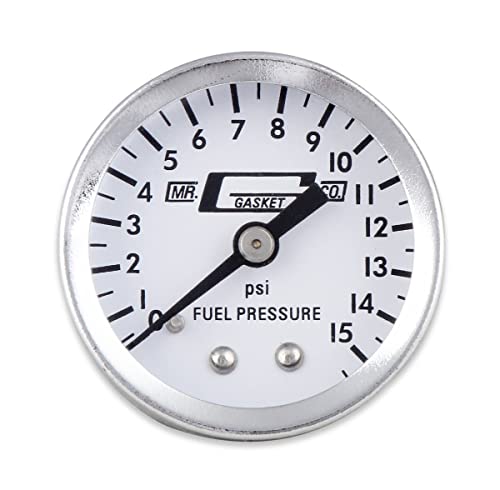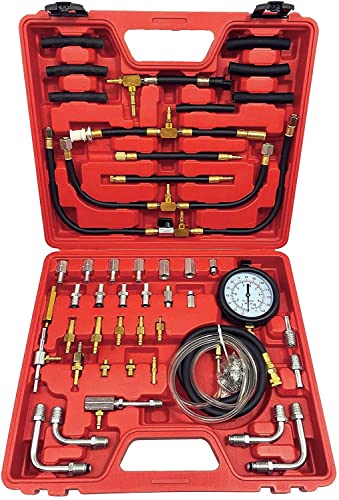Years ago, I found myself wrestling with a classic car’s temperamental engine. It wasn’t delivering consistent performance, and diagnosing the intermittent stutters and flat spots felt like chasing ghosts. I soon realized that without precise insights into my fuel system, I was merely guessing. This lack of information wasn’t just frustrating; it was a roadblock to optimal performance and could potentially lead to serious engine damage if I continued to run too lean or rich. A reliable tool, like the Mr. Gasket 1561 Fuel Pressure Gauge, would have been invaluable in those early days to pinpoint the exact fuel delivery issues and save me countless hours of trial and error.
- Accurately and reliably monitors fuel pressure
- Empowers you to easily make changes with an adjustable fuel pressure regulator
- Reads in half pound increments across a range from 0 to 15 pounds
Essential Considerations Before Acquiring a Fuel Pressure Monitor
When you’re trying to get the best out of your engine, especially if you’re dealing with a carbureted setup or an older fuel injection system, a fuel pressure gauge is an indispensable tool. It helps you accurately monitor your fuel pressure, which is crucial for optimal engine tuning, diagnosing fuel delivery issues, and preventing potential damage from incorrect fuel mixtures. Without a reliable gauge, you’re essentially operating blind, risking anything from poor fuel economy and reduced power to catastrophic engine failure.
The ideal customer for a fuel pressure gauge is the DIY mechanic, the performance enthusiast, or anyone committed to understanding and maintaining their vehicle’s fuel system. If you enjoy tinkering, fine-tuning your carburetor, or troubleshooting engine hiccups yourself, then this category of product is definitely for you. However, if you’re someone who prefers to leave all automotive work to professionals, or if your vehicle has a modern, complex EFI system that requires specialized diagnostic tools beyond a simple pressure reading, then a manual pressure gauge might not be your primary tool. In such cases, investing in a professional scan tool or simply consulting a certified mechanic would be more appropriate.
Before making a purchase, consider several factors:
* Pressure Range: Ensure the gauge’s range matches your vehicle’s fuel pressure requirements (e.g., 0-15 PSI for carbureted systems).
* Accuracy: A precise gauge is paramount for effective tuning and diagnostics.
* Material and Durability: Will it withstand engine bay heat and vibrations? Is the lens material resistant to fuel spills?
* Compatibility: Does it have the correct fitting (e.g., NPT) for your fuel system?
* Readability: Can you easily read the gauge face, even in dim light or cramped spaces?
* Size: Will it fit where you intend to install it?
* Fluid-filled vs. Dry: Fluid-filled gauges can dampen needle flutter but are prone to leaks and can struggle with heat, whereas dry gauges are less affected by temperature but may show more needle movement.
- UNIVERSAL FUEL PRESSURE TESTER: This pressure tester kit by Orion Motor Tech includes everything you need to quickly and easily check fuel pump pressure on most gasoline vehicles from Chevrolet, Ford,...
- 【Universal Design】:Fuel pressure Tester kit suits a variety of gasoline engines on car, truck, SUV, Motorcycle, ATV, RV, etc (Bosch, CIS Jetronic, Throttle Body System on GM vehicles excluded),...
- 【Fuel Injection Test Gauge Kit】: Fitted with 90mm gauge having two scales (psi and bar), reading from 0~140psi and 0~10bar
Introducing the Mr. Gasket 1561 Fuel Pressure Gauge
The Mr. Gasket 1561 Fuel Pressure Gauge is a compact, straightforward tool designed to provide accurate fuel pressure readings for low-pressure systems. It promises reliable monitoring, allowing you to fine-tune your fuel pressure regulator with confidence. When you purchase this gauge, you get the unit itself, ready to screw into any compatible 1/8-inch NPT female port.
In a market often dominated by more expensive, sometimes overly complex, or even unreliable fluid-filled alternatives, the Mr. Gasket 1561 carves out its niche. Many older designs, particularly oil-filled gauges, are notorious for leaking or failing under engine bay heat. This Mr. Gasket gauge directly addresses those common frustrations by being a dry gauge.
This particular fuel pressure gauge is perfect for anyone running a carbureted engine, a low-pressure EFI setup, or a classic car where precise fuel pressure around the 4-7 PSI range is critical. It’s less suitable for modern, high-pressure EFI systems that operate at much higher PSI ranges, as its maximum reading is 15 pounds. If you need a robust, high-pressure gauge, you’ll need to look elsewhere.
Here’s a quick look at its upsides and downsides:
Pros:
* Reliably monitors fuel pressure, crucial for accurate tuning.
* Dry gauge design avoids issues like oil leaks common with fluid-filled alternatives.
* Small size (1.5 inches) allows for versatile placement in tight engine bays.
* Easy-to-read white face with black numbers and a chrome bezel enhances visibility.
* Standard 1/8 NPT fitting ensures broad compatibility with existing fuel system components.
Cons:
* Plastic lens is susceptible to fogging or damage from fuel splashes.
* Reports of small screws on the back loosening over time.
* Some users have experienced the needle getting stuck behind the stop pin.
* Limited to a 0-15 PSI range, making it unsuitable for high-pressure EFI applications.
* Not as robust in construction compared to higher-end, metal-bodied gauges.
Deep Dive into Features and Practical Advantages
Having used the Mr. Gasket 1561 Fuel Pressure Gauge for a considerable period, I can attest to how its features translate into tangible benefits in the garage and on the road.
Accurate and Reliable Fuel Pressure Monitoring
One of the primary functions, and indeed the core promise, of the Mr. Gasket 1561 is its ability to accurately and reliably monitor fuel pressure. In my experience, once installed, this gauge consistently provides steady readings, especially once the engine is running smoothly. This consistency is a stark contrast to some cheaper, often oil-filled, gauges that can fluctuate wildly or simply stop working once the engine compartment heats up. The benefit here is immense: you’re not just getting a number; you’re getting a trustworthy reading that allows you to make informed decisions about your fuel system. For someone like me, who relies on precise data for troubleshooting, knowing that the gauge is giving me an accurate picture of my fuel pressure is absolutely critical for preventing issues like a lean condition, which can quickly lead to engine damage.
Empowers Easy Adjustments with Adjustable Fuel Pressure Regulators
The ability to easily make changes with an adjustable fuel pressure regulator is directly linked to the gauge’s reliability. When you’re fine-tuning a carburetor or optimizing a low-pressure EFI system, you need immediate and accurate feedback as you turn that adjustment screw. This gauge excels here, allowing for precise, real-time adjustments. For my carbureted setup, maintaining the fuel pressure at an optimal 6.5 PSI is paramount to prevent issues like over-pressuring the needle and seats, which can lead to flooding. The Mr. Gasket 1561 acts as your eyes on the fuel line, enabling you to dial in that sweet spot, ensuring your engine gets exactly the fuel it needs without waste or detrimental pressure spikes. This means improved fuel efficiency, smoother idle, and peak performance, all without the guesswork.
Precision Readings: Half-Pound Increments Across 0-15 Pounds
The fact that this gauge reads in half-pound increments across a range from 0 to 15 pounds is a testament to its suitability for specific applications. Many carbureted engines, especially older ones, thrive within a relatively narrow and low pressure range (e.g., 4-7 PSI for Carter’s/Edelbrocks). Having half-pound increments allows for incredibly precise adjustments within this critical zone. You’re not just seeing “around 5 PSI”; you’re seeing 4.5, 5.0, 5.5 PSI, which can make a significant difference in how your engine runs. This level of granularity helps prevent both starvation (too little pressure) and flooding (too much pressure), leading to a healthier, more predictable engine, especially in consistent, long-term operation.
Broad Compatibility with 1/8 Inch NPT Female Ports
Compatibility is key in the automotive world, and the Mr. Gasket 1561 shines with its compatibility with any 1/8 inch NPT female port. This is a common standard, meaning the gauge can be easily integrated into most fuel pressure regulators, fuel blocks, or custom fuel lines with the correct adapter. For me, installing it onto a feed port on my return-style regulator was a breeze. I used a bit of Teflon tape, a few threads above the base, and it sealed perfectly on the first try. This broad compatibility means less hassle, fewer additional parts to buy, and a quicker, more straightforward installation process for a wide range of vehicles, making it a truly versatile tool for any DIY enthusiast.
Clear Display and Aesthetics: 270-Degree Sweep, White Face, Black Numbers, Chrome Bezel
Beyond functionality, the visual aspects of a gauge matter. The Mr. Gasket 1561 features a 270-degree sweep, an easy-to-read white face with black numbers, and a stylish chrome bezel. This design makes it incredibly easy to get a quick, accurate reading even in a busy engine bay. The contrast between the white face and black numbers is excellent, and the wide sweep of the needle provides clear differentiation between pressure points. While some might prioritize pure utility, the clean aesthetic also means it doesn’t look out of place in a well-maintained engine compartment. It just “looks good” and matches other older school gauges, adding a touch of classic appeal. However, a significant drawback here, as I’ve experienced, is the plastic lens. It’s highly susceptible to fogging if even a tiny amount of gasoline splashes on it, making the gauge unreadable. This is a design oversight that requires extreme caution during installation and any subsequent fuel system work. A glass lens would have been a significant improvement.
Compact Size: Small 1.5-Inch Gauge
Its small 1.5-inch screen size is another practical advantage. In today’s crowded engine bays, space is often at a premium. The compact nature of this gauge means it can be tucked away almost anywhere you need it, whether directly on the fuel rail, a regulator, or a test port. This flexibility in placement ensures you can install it where it’s most convenient for monitoring without interfering with other components. For my setup, where every inch counts, this small footprint was a huge plus, allowing me to keep my engine bay neat and functional.
The Indispensable Tool for Pressure Adjustments
The product description reiterates that this gauge is “a must when pressure adjustments are necessary.” This isn’t just marketing fluff; it’s a profound truth for anyone working on their vehicle’s fuel system. Without a reliable fuel pressure gauge, you’re relying on guesswork, which can lead to a host of problems from poor performance to potential engine damage. Over my years of use, this Mr. Gasket gauge has been an essential part of my tuning toolkit. It provides the confidence needed to make precise adjustments, ensuring my engine runs efficiently and reliably, preventing issues like blown needle and seats from over-pressuring. It brings a level of certainty to an otherwise complex system, making it a foundational tool for diagnostics and optimization. However, I must mention that there have been instances where the small screws in the back of the housing have come loose, and some users have reported the needle getting stuck behind the peg. While not universal experiences, these issues highlight areas where the product’s long-term durability could be improved, requiring users to occasionally re-tighten screws or verify the needle’s position.
Voices from the Road: User Experiences
Having scoured various online communities and product reviews, it’s clear that the Mr. Gasket 1561 Fuel Pressure Gauge largely garners positive feedback, particularly from those tired of issues with traditional oil-filled alternatives. Many users highlight its impressive resilience to engine bay heat, a common failing point for its competitors that would often stop registering. The relief of not having to deal with messy oil spills from broken gauges is a recurring sentiment. Owners frequently praise its simple installation and the consistent readings it provides for their carbureted systems. While the plastic lens’s vulnerability to fuel is a noted downside, users who are careful generally find the gauge reliable for monitoring vital fuel pressures, especially for specific applications like 383 strokers or classic setups where stable low pressures are critical.
Final Thoughts: Ensuring Optimal Fuel System Performance
The enduring problem for many automotive enthusiasts and DIY mechanics is the precise management and diagnosis of their vehicle’s fuel system. Without accurate information, they risk suboptimal performance, wasted fuel, and even severe engine damage. The Mr. Gasket 1561 Fuel Pressure Gauge offers a compelling solution to this challenge. It’s a great fit due to its accurate and reliable monitoring capabilities, its dry gauge design that eliminates common failure points of oil-filled units, and its precise half-pound increment readings, which are ideal for carbureted and low-pressure EFI systems. For consistent, no-guesswork fuel pressure readings that help keep your engine healthy and performing optimally, this gauge proves to be an indispensable tool. To bring precision and peace of mind to your automotive endeavors, Click here to check the product out.
Last update on 2025-11-11 / Affiliate links / Images from Amazon Product Advertising API




